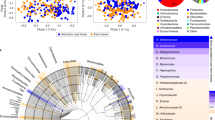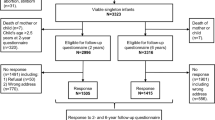Abstract
Allergens in house dust are risk factors for asthma causation and exacerbation, and asthma interventions often focus on exposure reduction using methods that may not be sustainable over time in low-income communities. A randomized controlled trial with up to six home visits was used to evaluate the effectiveness of two interventions focused on reducing dust loading and allergen concentrations in 47 low-income inner-city households in Minneapolis, MN. The interventions, which included education and relatively inexpensive cleaning procedures, were developed using a community-based participatory consultation process with focus groups held in English, Somali, and Spanish to incorporate community feedback from participants into protocols and study design decisions. Change in levels of cat, cockroach, dust mite, and culturable fungi as well as overall dust loading were evaluated by measuring the difference in concentrations before and after the cleaning intervention, and mixed models were used to assess the effect of education and cleaning on baseline allergen levels during the final three home visits. The cleaning intervention significantly lowered dust loading in all households and culturable fungi levels in single family homes, reduced cat allergen concentrations in homes with cats, but had no significant effect on cockroach allergen levels. The cleaning intervention also modestly decreased the frequency of observed allergen concentrations above suggested health benchmarks for cat, cockroach, and fungi. The cleaning and education interventions had similar effects on baseline allergen levels measured during subsequent home visits; both interventions significantly reduced baseline levels of cat and fungal allergens observed in pre-cleaning samples, but had no significant effect on cockroach allergen levels. Overall, the cleaning intervention modestly reduced potential exposure to risk factors associated with asthma mortality and morbidity in a way that can be implemented by most homeowners or renters, independent of education, income, or the ability to speak English.
This is a preview of subscription content, access via your institution
Access options
Subscribe to this journal
Receive 6 print issues and online access
$259.00 per year
only $43.17 per issue
Buy this article
- Purchase on Springer Link
- Instant access to full article PDF
Prices may be subject to local taxes which are calculated during checkout

Similar content being viewed by others
Abbreviations
- Bla g1:
-
Blatella germanica protein 1
- CFU:
-
colony-forming unit
- CV:
-
coefficient of variation (%)
- Der f1:
-
Dermatophagoides farinae protein 1
- Der p1:
-
Dermatophagoides pteronyssinus protein 1
- ELISA:
-
enzyme-linked immunosorbent assay
- Fel d1:
-
Felis domesticus protein 1
- GM:
-
geometric mean
- HARS:
-
Home Allergen Reduction Study
- NCICAS:
-
National Cooperative Inner City Asthma Study
- SHIELD:
-
Schools Health Initiative: Environment Learning and Disease Study
References
Arbes Jr S.J., Cohn R.D., Yin M., Muilenberg M.L., Friedman W., and Zeldin D.C. Dog allergen (Can f 1) and cat allergen (Fel d 1) in US homes: results from the National Survey of Lead and Allergens in Housing. J Allergy Clin Immunol 2004: 114 (1): 111–117.
Carter M.C., Perzanowski M.S., Raymond A., and Platts-Mills T.A. Home intervention in the treatment of asthma among inner-city children. J Allergy Clin Immunol 2001: 108 (5): 732–737.
Chan-Yeung M., Ferguson A., Watson W., Dimich-Ward H., Rousseau R., Lilley M., Dybuncio A., and Becker A. The Canadian Childhood Asthma Primary Prevention Study: outcomes at 7 years of age. J Allergy Clin Immunol 2005: 116 (1): 49–55.
Chapman M.D., Heymann P.W., Wilkins S.R., Brown M.J., and Platts-Mills T.A. Monoclonal immunoassays for major dust mite (Dermatophagoides) allergens, Der p I and Der f I, and quantitative analysis of the allergen content of mite and house dust extracts. J Allergy Clin Immunol 1987: 80 (2): 184–194.
Chew G.L., Higgins K.M., Gold D.R., Muilenberg M.L., and Burge H.A. Monthly measurements of indoor allergens and the influence of housing type in a northeastern US city. Allergy 1999: 54 (10): 1058–1066.
Cho S., Ramachandran G., Grengs J., Ryan A., Eberly L., and Adgate J.L. Longitudinal evaluation of allergen and culturable fungal concentrations in inner-city households. J Occup Environ Hyg 2007 (in press).
Eggleston P.A., and Wood R.A. Management of allergies to animals. Allergy Proc 1992: 13 (6): 289–292.
Elliott L., Arbes S., Harvey E., Lee R., Salo P., Cohn R., London S., and Zeldin D. Dust weight and asthma prevalence in the national survey of lead and allergens in houseing (NSLAH). Environ Health Perspect 2007: 115: 215–220.
Greaves I.A., Sexton K., Blumenthal M.N., Church T.R., Adgate J.L., Ramachandran G., Fredrickson A.L., Ryan A.D., and Geisser M.S. Asthma, atopy, and lung function among racially diverse, poor inner-urban Minneapolis schoolchildren. Environ Res 2007: 103 (2): 257–266.
HUD. Healthy Homes Issues: Asthma. US Department of Housing and Urban Development, Office of Healthy Homes and Lead Hazard Control, Washington, DC, 2001.
IOM. Damp Indoor Spaces and Health. National Academies Press, Washington, DC, 2004.
Israel B.A., Schulz A.J., Parker E.A., and Becker A.B. Review of community-based research: assessing partnership approaches to improve public health. Annu Rev Public Health 1998: 19: 173–202.
Kitch B.T., Chew G., Burge H.A., Muilenberg M.L., Weiss S.T., Platts-Mills T.A., O'Connor G., and Gold D.R. Socioeconomic predictors of high allergen levels in homes in the greater Boston area. Environ Health Perspect 2000: 108 (4): 301–307.
Krieger J.W., Takaro T.K., Song L., and Weaver M. The Seattle-King County Healthy Homes Project: a randomized, controlled trial of a community health worker intervention to decrease exposure to indoor asthma triggers. Am J Public Health 2005: 95 (4): 652–659.
Leaderer B.P., Belanger K., Triche E., Holford T., Gold D.R., Kim Y., Jankun T., Ren P., McSharry Je J.E., Platts-Mills T.A., Chapman M.D., and Bracken M.B. Dust mite, cockroach, cat, and dog allergen concentrations in homes of asthmatic children in the northeastern United States: impact of socioeconomic factors and population density. Environ Health Perspect 2002: 110 (4): 419–425.
Levy J.I., Brugge D., Peters J.L., Clougherty J.E., and Saddler S.S. A community-based participatory research study of multifaceted in-home environmental interventions for pediatric asthmatics in public housing. Soc Sci Med 2006: 63 (8): 2191–2203.
Morgan W.J., Crain E.F., Gruchalla R.S., O'Connor G.T., Kattan M., Evans III R., Stout J., Malindzak G., Smartt E., Plaut M., Walter M., Vaughn B., and Mitchell H. Results of a home-based environmental intervention among urban children with asthma. N Engl J Med 2004: 351 (11): 1068–1080.
NRC. Clearing the Air: Asthma and Indoor Air Exposures. National Academy Press, Washington, D.C, 2000.
NRC/IOM. Ethical Considerations For Research on Housing-Related Health Hazards Involving Children. National Academies Press, Washington, DC, 2005.
Ramachandran G., Adgate J.L., Banerjee S., Church T.R., Jones D., Fredrickson A., and Sexton K. Indoor air quality in two urban elementary schools — measurements of airborne fungi, carpet allergens, CO2, temperature, and relative humidity. J Occup Environ Hyg 2005: 2 (11): 553–566.
Rosenstreich D.L., Eggleston P., Kattan M., Baker D., Slavin R.G., Gergen P., Mitchell H., McNiff-Mortimer K., Lynn H., Ownby D., and Malveaux F. The role of cockroach allergy and exposure to cockroach allergen in causing morbidity among inner-city children with asthma. N Engl J Med 1997: 336 (19): 1356–1363.
Sexton K., Greaves I.A., Church T.R., Adgate J.L., Ramachandran G., Tweedie R.L., Fredrickson A., Geisser M., Sikorski M., Fischer G., Jones D., and Ellringer P. A school-based strategy to assess children's environmental exposures and related health effects in economically disadvantaged urban neighborhoods. J Expo Anal Environ Epidemiol 2000: 10 (6 Part 2): 682–694.
Swartz L.J., Callahan K.A., Butz A.M., Rand C.S., Kanchanaraksa S., Diette G.B., Krishnan J.A., Breysse P.N., Buckley T.J., Mosley A.M., and Eggleston P.A. Methods and issues in conducting a community-based environmental randomized trial. Environ Res 2004: 95 (2): 156–165.
Takaro T.K., Krieger J.W., and Song L. Effect of environmental interventions to reduce exposure to asthma triggers in homes of low-income children in Seattle. J Expo Anal Environ Epidemiol 2004: 14 (Suppl 1): S133–S143.
Vojta P.J., Randels S.P., Stout J., Muilenberg M., Burge H.A., Lynn H., Mitchell H., O'Connor G.T., and Zeldin D.C. Effects of physical interventions on house dust mite allergen levels in carpet, bed, and upholstery dust in low-income, urban homes. Environ Health Perspect 2001: 109 (8): 815–819.
Wood R.A., Eggleston P.A., Lind P., Ingemann L., Schwartz B., Graveson S., Terry D., Wheeler B., and Adkinson Jr N.F. Antigenic analysis of household dust samples. Am Rev Respir Dis 1988: 137 (2): 358–363.
Wu F., and Takaro T.K. Childhood asthma and environmental interventions. Environ Health Perspect 2007: 115, (doi:10.1289/ehp.8989, online January 25, 2007) 971–975.
Acknowledgements
This research was funded by Healthy Homes Technical Study Grant MNLHH0122-03 from the Department of Housing and Urban Development (HUD). We are especially grateful to our participant families and the HARS field study staff. Mention of commercial services or brands does not imply endorsement by the University of Minnesota or HUD.
Author information
Authors and Affiliations
Corresponding author
Rights and permissions
About this article
Cite this article
Adgate, J., Ramachandran, G., Cho, S. et al. Allergen levels in inner city homes: baseline concentrations and evaluation of intervention effectiveness. J Expo Sci Environ Epidemiol 18, 430–440 (2008). https://doi.org/10.1038/sj.jes.7500638
Received:
Accepted:
Published:
Issue Date:
DOI: https://doi.org/10.1038/sj.jes.7500638
Keywords
This article is cited by
-
Does soil track-in contribute to house dust concentrations of perfluoroalkyl acids (PFAAs) in areas affected by soil or water contamination?
Journal of Exposure Science & Environmental Epidemiology (2019)
-
The Role of Home Environments in Allergic Disease
Clinical Reviews in Allergy & Immunology (2019)
-
Asthma
Nature Reviews Disease Primers (2015)
-
Performance of dust allergen carpet samplers in controlled laboratory studies
Journal of Exposure Science & Environmental Epidemiology (2013)
-
Practices contributing to biotic pollution in Air-conditioned indoor environments
Aerobiologia (2011)



